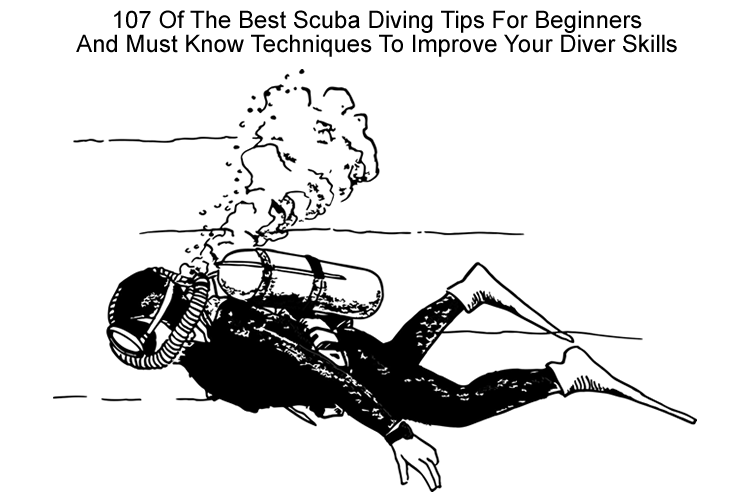
107 of the best pro tips for scuba diving beginners to improve your diver skills
As a beginner scuba diver there are many things to learn and master. Which is why I’ve put together this list of pro tips for beginner scuba divers to help you along the way.
The best way to do more diving and to improve your skills using the following tips, is to book yourself on a scuba diving liveaboard. You can check the latest and best deals on liveaboards using the following window:
Top pro tips for beginner scuba divers by category:
Each of the following tips for beginner scuba divers include the top tip from each of the categories. Jump to each category to see the full list of pro tips to enhance your diving skills.
A. Learning to scuba dive: Choose the right dive centre to learn diving.
B. Scuba diving equipment: Get a dive computer.
C. Diving from a dive boat: Putting a weight belt on in choppy waters.
D. Buoyancy control: Add small amounts of air to BCD.
E. Scuba diver dive descent: Relax.
F. Underwater navigation: Dive with a compass.
G. Scuba diving travel: Wait 24 hours to fly after diving.
H. Wildlife scuba diving: Spotting the small sea life.
I. Air conserving scuba diving: Dive with the correct weight.
J. Scuba dive time extension: Check your contents gauge before you dive.
K. Scuba diving safety: Plan your dive and dive your plan.
L. Scuba buddy diving: Always do buddy checks.
M. Health Tips: Stay hydrated.
If there’s one lasting point to take away from this post about tips for beginner scuba divers is to have fun and enjoy scuba diving.
Dive safely and within your own limitations. This list of tips for beginner scuba divers can be used by more advanced divers too, as you can always learn more.
A. Learning tips for beginner scuba divers
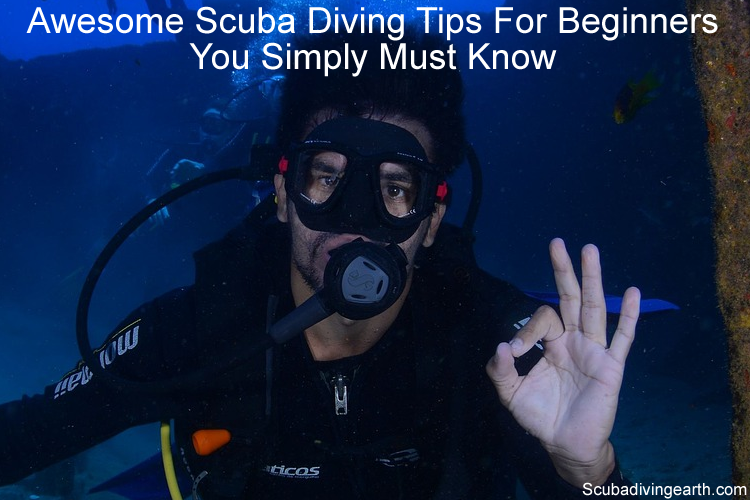
- Get confident in the water.
- Choose the right dive centre to learn diving.
- Do a try-dive in a pool.
- Learn to snorkel before you learn how to scuba dive.
- Ask lots of questions.
- Progressing your learning and experience.
- Don’t be afraid to ask to change your buddy before a dive.
- The okay signal is a question and an answer.
- Go with the current when diving in currents.
- Mask clearing tips for beginner divers.
- Clear your ears on descent.
- Dive mask fogging tips.
- Prevent scuba diver mask squeeze.
- Build up your experience and dive as much as you can.
- Practice recovering your regulator.
- Blood in your mask at the surface.
- Know the signs of nitrogen narcosis.
- Keep a log of your scuba dives.
- Diving from a beach tips.
- Take things slowly and don’t be a learning junkie.
- Scuba diving in lakes.
1. Get confident in the water
It’s exciting when you first learn how to scuba dive, but if you’re not 100% confident in water you may get into trouble.
During the PADI scuba diving course or the BSCA diving course you will have to swim 200 metres (656 feet) and be able to tread water for 10 minutes.
If these two test don’t put you off you can head straight to the dive centre. But if you have any concerns you are better to improve your swimming skills first.
As with any sport confidence in your abilities is important. But confidence plays an even bigger role in scuba diving because the sport is in a foreign underwater environment.
If anything goes wrong confidence plays a huge part in surviving the incident. In a DAN survey 40 to 60% of scuba diver deaths were associated with panic.
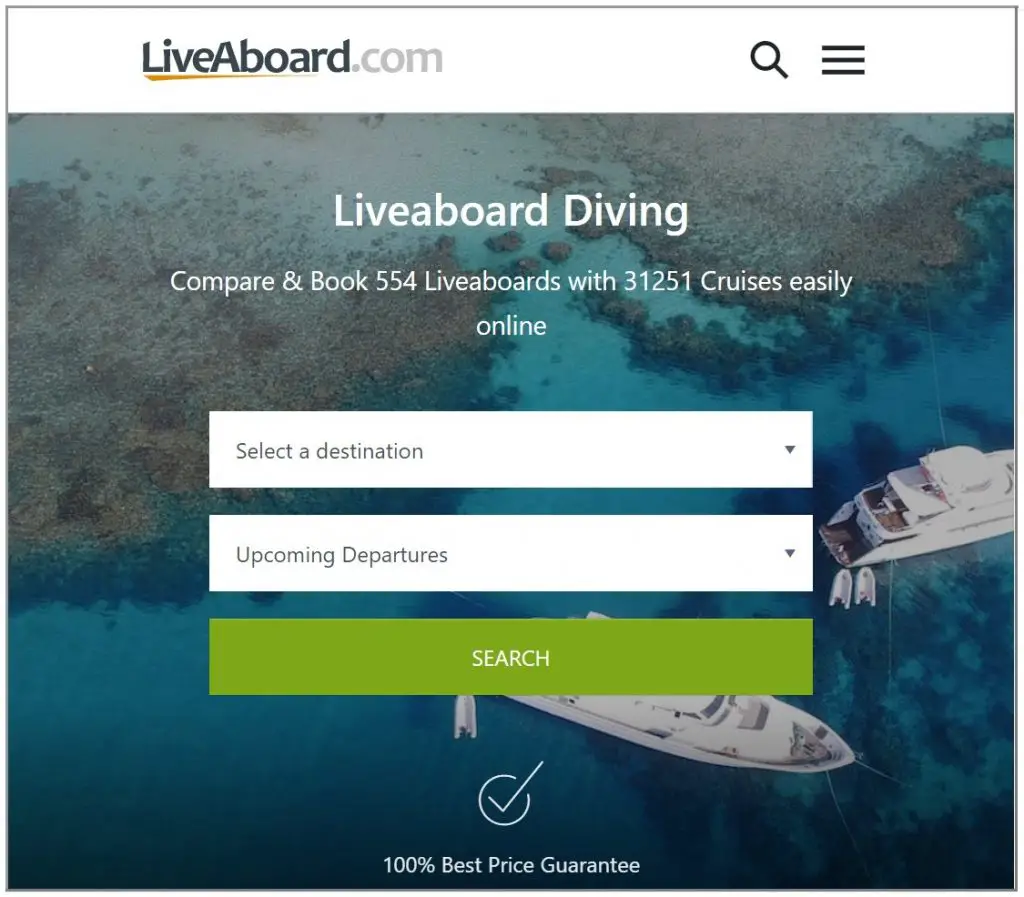
2. Choose the right dive centre to learn diving
Choose your dive centre carefully as they are not all the same and some are better than others. It will be cheaper to learn scuba near where you live if that’s possible.
The start of the training normally begins in a pool, but then progresses to open water. Choose a training centre where the dive sites and diving conditions are suitable for beginner divers.
It’s easier to learn to scuba dive in warm clear blue waters like the Caribbean, but this can be expensive. That’s not to say you can’t learn to dive in colder waters, like around the UK or north America and Canada. If you learn to dive in places like the UK, diving in blue Caribbean waters is so much easier.
3. Do a try-dive in a pool
If you’ve never tried scuba diving before you should go for a try-dive first in a pool. You can also do a test dive with some dive centres in shallow safe open water too, but this will be under the guidance of a qualified scuba instructor.
By doing a test dive you get to try out all the equipment and discover what it’s like to breathe underwater from an aqualung. Some love it and progress to learn scuba, but others find out it’s not for them so don’t progress their training.
4. Learn to snorkel before you learn how to scuba dive
The three pieces of equipment used in snorkelling and scuba diving are your mask, snorkel and fins. Snorkelling will give you added confidence in the water and help you get to grips with using a mask and breathing with your mouth.
If you already have plenty of confidence, if you spend plenty of time snorkelling too this will give you a head-start to the training.
5. As a beginner scuba diver you should be asking lots of questions
If you don’t know, don’t be afraid to ask. Always remember there are no stupid questions in scuba diving. If you’re afraid to ask your instructor, ask in the comments below or on our forum for scuba diver beginners.
It’s better to know and be safe than to not know and for something go horribly wrong. The answer to your question may also help the enjoyment of the dive too.
6. Progressing your learning and experience of scuba diving
If your intention is to scuba dive in waters that are different to where you learnt to scuba dive, you must get more training. For example, diving in colder and lower visibility seas require additional training and support whilst you’re a beginner scuba diver.
7. Don’t be afraid to ask to change your buddy before a dive
As a beginner scuba diver it’s important you’re totally comfortable and have confidence in your dive buddy. If you are allocated a dive buddy with a scuba diver who you don’t have confidence with for whatever the reason, ask for them to be changed.
You want to feel comfortable under the water so you can focus on enjoying the dive, rather than spending your time worrying about your buddy.
More Reading: How do I get a dive buddy? (5 easy ways to find a dive buddy)
8. The okay signal is a question and an answer
The most used scuba diving signal is the okay signal. It’s always worth remembering that the okay signal is both a question and an answer. So if any other scuba diver gives the okay signal to you, always respond with the same (of course only if you’re okay, if not respond appropriately).
If you give the okay signal to another scuba diver and they don’t return it, make sure they are okay. If not, act appropriately.
9. Go with the current when diving in currents
No matter how strong the current, always swim with the current and never against it. You’ll save energy and air by going with the current, and with stronger currents (i.e. drift dives), this is great fun, as it’s like flying.
10. Mask clearing tips for beginner divers
When you perform a mask clear, learn to do this one handed. The easiest way to mask clear one handed is to use your index finger. Press your index finger on the top of your mask as your exhale through your nose, as you do so, tilt your head back slightly too. Any water in your mask will be pushed out.
It’s important to learn this one-handed mask clearing technique for times when your other hand is required for something else. This could include holding on to the ascent rope that leads you to the surface.
11. Clear your ears on descent
Never leave clearing your ears until it becomes painful, as there’s a risk of perforating your eardrum. If you’re having difficulty in clearing your ears on your descent, sometimes by coming up a few metres of feet can help the ear clearing process.
Never continue a dive if you’re unable to clear your ears. Don’t dive if you have a cold or a sinus infection. Also, don’t use decongestants when scuba diving.
12. Dive mask fogging tips
The best tip for preventing scuba dive mask fogging is to use baby shampoo on the inside of your mask. Always rinse the mask before you put it on your face, to avoid getting neat baby shampoo in your eyes, despite it’s hypoallergenic qualities.
Also, keep your mask clean, as this also helps prevent mask fog. To read a complete article on preventing mask fog please follow this link: How To stop Your Dive Mask From Fogging Up (8 Great Ideas That Work).
13. Prevent scuba diver mask squeeze
To prevent mask squeeze on your scuba dive descent, make sure you blow through your nose into your mask as you descend to equalise the pressure of the mask airspace. The result of forgetting to do this is more embarrassing than dangerous, as you may ascend from your dive with bloodshot eyes and a bit of a rash around your face.
14. Build up your experience and dive as much as you can
Once you’ve gained your scuba diver certification, you should build your experience by doing as much diving as you can. For example, in the DAN Annual Diving Report 2016 edition, they cited “Diving more often (or more pre-trip refresher training),” as one of the 10 most wanted improvements in Scuba diving.
15. Practice recovering your regulator
Scuba divers occasionally lose their regulator and have it knocked from their mouths whilst diving. It’s good to practice safe recovery of your regulator on a regular basis. Always confirm your intentions to your dive buddy and to the dive master too before you descend on your dive. Only practice regulator recovery with your dive buddy watching on.
16. Blood in your mask at the surface
Never be too concerned about the presence of blood in your mask when you ascend from a dive. This is normally due to the pressure of the water at depth acting on your sinuses. If you suffer from sinus problems, it’s often said that scuba diving can improve the symptoms. However, if the symptoms persist and if you are worried, always seek medical advice of attention.
17. Know the signs of nitrogen narcosis
As you progress as a scuba diver and become more adventurous, you may begin to dive a bit deeper. Once you descend below around 30 metres (98 feet), there’s the possibility of getting nitrogen narcosis. Be aware of what this is and the affects of the problem for yourself and to watch out for in your dive buddy too.
18. Keep a log of your scuba dives
Keeping a log of your scuba dives serves two purposes. The first is to help with your diver training and provides a record of progression of experience, as you work yourself up the qualification scales. The second is a record for yourself to remember where and what you dived.
19. Diving from a beach tips
The best way to dive from a beach is firstly to find one where the wave action is not excessive. Also, once you have your fins on, you are better off walking backwards into the water.
20. Take things slowly and don’t be a learning junkie
Don’t rush to qualify to the next level of scuba diving. Take things slow and build your experience slowly and safely.
21. Scuba diving in lakes
Scuba diving in lakes can be fun and you can see wildlife there too. However, be prepared for the water to be very cold. Also, lakes are an excellent place for scuba training where you don’t live near to the coast.
B. Scuba diving equipment tips for beginner scuba divers

22. Treat your scuba equipment as an investment
If you invest well in scuba diving equipment, it will last. You don’t always have to buy the most expensive scua gear, but buy good quality brands with great reviews.
23. Look after your scuba equipment and your equipment will look after you
After every dive always wash your scuba equipment in fresh water. Have your scuba kit serviced and maintained on a regularly basis, as some of your scuba equipment is your life-support system. You’re entering a foreign environment where you need to be able to rely on your equipment not to fail.
In the DAN study of diving fatalities, 15% related to equipment problems, with 14% of deaths where regulator fault was reported.
24. Get yourself a dive computer
Whilst it’s possible to dive without a dive computer, having one makes diving so much easier. When I learnt to dive, whilst dive computers were available, they were not really trusted at the time and not often used. So I know what it’s like to dive without one. I prefer to dive with a dive computer, as it’s safer and easier.
However, a quick safety tip, make sure you know how to dive without a dive computer, should yours fail.
25. Diving with a knife
If you can dive with a scuba diver’s knife, do so. This is not for killing sea-life, but is for your safety and to cut yourself free from lines or nets underwater. Most dive masters and boat skippers don’t allow diver’s knives, so check with them before you don your knife.
Also, if you’re traveling to another country, check their knife laws first, before you bring yours into a foreign airport.
26. Buy an underwater writing pad
Communication underwater is limited to hand signals. However, if you have a writing pad, you’ll be able to write notes, ask questions and write comments on your pad.
27. Have an implement you can use to attract the attention of another scuba diver
The best way to attract the attention of a fellow scuba diver is through noise. Noise carries well underwater, although the direction of the noise is not always easy to calculate.
However, most divers will look around when a noise is made, so have something you can use to tap on your scuba tank. This is useful for attracting the attention of other divers if you’ve seen something of interest.
28. Always take a torch on your dives; even the daytime dives
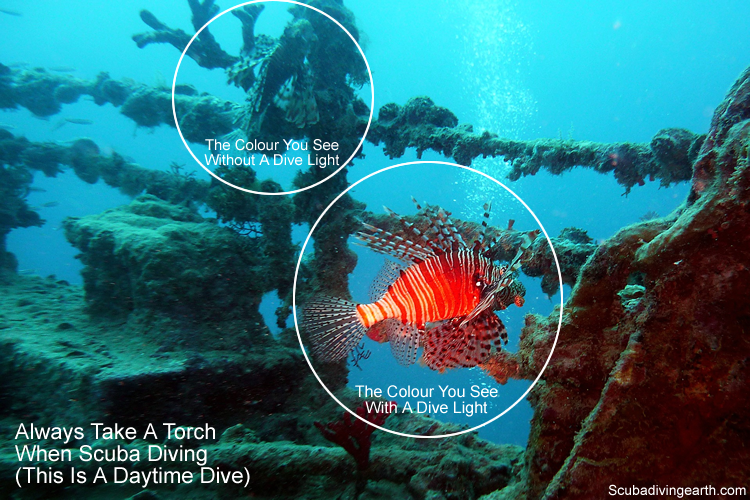
Having a torch underwater is a must-have piece of diving equipment. Most divers only carry a torch for night dives, however, a torch is also great to have on daytime scuba dives too. As you descend on a dive the colours are lost as the suns rays cannot penetrate the depths. So a torch can be used to illuminate things to bring back their colour.
Notice the two Red Lionfish in the above image. Well one’s red and the other one almost fades into the background. It’s amazing what extra things and colours you see with a dive torch or light.
A torch is also useful for looking in holes, caves and crevices to look for underwater creatures. A torch is also a must have on wreck dives for looking into and illuminating the wreck.
More Reading: Why use a diving torch scuba diving (It’s not just for night diving)
29. Carry a delayed surface marker buoy (SMB) or diver safety sausage
For added safety on all dives it’s a good idea to carry a delayed surface marker buoy (SMB) or what some call a diver safety sausage.
An SMB can be used to help you with a safe ascent, it can help the dive boat spot you in choppy waters and is very useful if a current starts to run whilst you are on your dive. The buoy gives the dive boat something to follow when you are drifting in the current.
More Reading: What is a delayed surface marker buoy? (Safety diving equipment)
30. Choosing a mask for scuba diving
The two most important aspects of a scuba diving mask are comfort and having a mask that doesn’t leak. After a long dive at depth, if your mask isn’t comfortable, your face will become soar, so choose your mask wisely.
To make sure you get a good fit, wear the mask on your face without the strap and breath in through your nose. If the mask fails to stick to your face with an airtight seal, this isn’t the right mask for your face. Try others until you find one where this exercise creates an airtight seal and the mask stays on your face only by breathing in through your nose.
31. How to choose a wetsuit for scuba diving
There are two considerations for a wetsuit for scuba diving. The first is for warmth and insulation. Get the right wetsuit thickness for the temperature of water you intend to dive in. The second consideration is buoyancy. The thicker the wetsuit, the more buoyant it will be.
The more buoyant you are, the more weight you’ll need and the less efficient you’ll be underwater. As a consequence, you’ll consume more air and shorten your dive time. So ideally only choose a wetsuit thickness that is sufficient to keep you well insulated and warm in the water temperature you’re diving.
32. How to choose a dry suit for scuba diving
In colder waters, instead of a wetsuit or even a semi-dry suit, you may wish to consider buying a dry suit.
There are three types of drysuit, neoprene, crushed neoprene and membrane. Each has its pros and cons, each of which you’ll need to weigh up before you choose.
33. Scuba divers that require glasses to see
There are plenty of options open to scuba divers if they need to wear glasses to see. On this article about full face snorkel masks, I cover the topic of snorkeling with glasses.
The same principles apply to scuba diving too. There are many options now of adapting your existing scuba mask or of buying a new one which incorporates lenses to see underwater.
C. Diving from a dive boat tips for beginner scuba divers
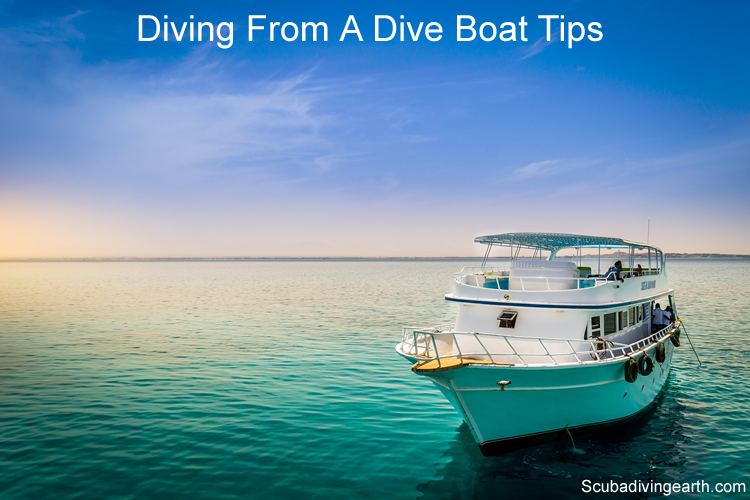
34. Dive boat etiquette
Always remember on a dive boat to be courteous to fellow scuba divers. Keep your equipment tidy and safe and when kitted up be careful not to bump into other divers. This can sometimes be a challenge in choppier seas.
35. Getting into the water from a dive boat
When you entering the water from a dive boat be aware of other divers in the water.
Wait for the skipper to give you the okay to jump in. Always come to the surface first after you jump in, before you descend. This confirms that all is okay to the skipper or fellow divers still on the boat.
36. Make sunscreen a part of your diving equipment
When you’re out on a boat in the sun, there’s a double affect of the suns rays. The first is directly from the sun and the second is the rays that bounce off the water. Always take plenty of sunscreen to protect your skin from sun burn.
37. Putting a weight belt on in choppy waters
A tip for putting your weight belt on when you’re on a dive boat in choppy waters.
First put your weight belt behind your calves holding it in both hands. Then stand with your legs at least shoulder width apart. Bend forward and and bring your weight belt to its correct position on your waist. Buckle the weight and then stand up.
D. Buoyancy control tips for beginner scuba divers

To read more about how to achieve neutral buoyancy scuba diving made easy, read this article on buoyancy control.
38. Aim for neutral buoyancy at the start of your dive
Aim to be neutrally buoyant as early into the dive as you can. The earlier you are neutrally buoyant on your dive, and by doing so with the least amount of air adjustments to your BCD, the more air you’ll conserve and the more you’ll be able enjoy your dive.
39. Set your buoyancy and leave your BCD inflator and dump valves alone
All experienced scuba divers set their the buoyancy as they reach the bottom and then leave their buoyancy controls alone. Your aim should to do the same and then leave your buoyancy control device inflator and the dump values alone. That is; set it and forget it.
The only time you should touch your BCD buoyancy controls is either to correct your buoyancy where the dive depth has changed, or to dump air from your BCD during your ascent to the surface.
40. Add and subtract just small amounts of air to and from your BCD
You should only add small amounts of air to your BCD to adjust your buoyancy, as you become progressively buoyant as you descend on your dive. Also, when you dump air to reduce your buoyancy, for example on your ascent, you should only dump small amounts of air at a time.
The only time where there’s an exception to this rule is in the final 6 metres (20 feet) of your ascent to the surface, which due to the larger change in water pressure in this depth of your dive.
41. How to avoid touching the sea bed on your descent
When you descend on your dive you should begin to add small amounts of air to your buoyancy control device as your approach the bottom. Don’t leave this to the last minute, otherwise you risk bumping into the bottom or over-inflating your BCD to slow your ascent quickly at the last minute.
If you over-inflate your BCD, in order to slow yourself down quickly, you’ll waste precious air and shorten your dive time. Plus you may bump into what’s on the bottom which may be coral, and you don’t want to be destroying what you’ve gone down to see.
42. Buoyancy tip for diving over deep drop-offs
As with the previous tip, as you approach your required depth, begin to add small amounts of air to your BCD. Don’t wait until you reach your planned dive depth to adjust your buoyancy, as you’ll end up going deeper.
Also, you’ll end up adding too much air to slow yourself down quickly , which will result in dumping the excess to compensate your ‘over-buoyancy,’ therefore wasting valuable air and reducing your dive time.
43. Use your lungs to vary your dive depth
To adjust your dive depth you can sometimes use your lungs to do this. To make yourself more negatively buoyant you should breath out. This is a technique that’s good to use at the start of your dive to help you begin your descent.
You can also reduce your buoyancy by breathing out when you are on your dive to look under crevices or overhangs. Using this technique avoids the need to dump air from your BCD. You can also use your lungs to increase your buoyancy by breathing in more. This techniques helps when you are swimming over an outcrop. But when you use your lungs to increase your buoyancy, don’t hold your breath and never over-inflate your lungs either.
Note: Never use this technique for a permanent change in depth on your dive.
44. Diver controlled ascents
A key part to safe diving is a controlled buoyant ascent. All dives are decompression dives (see this article on emergency decompression stops vs safety stops), as our bodies are compressed underwater.
The compression effect is that nitrogen is dissolved into our body. On the ascent, scuba divers must ascend slowly to allow the slow release of this nitrogen, without risking the dangerous side-affects of bubbles forming in the tissues.
An agreed safe ascent rate is around 9 metres (30 feet) per minute. However, on some dives a decompression stop is required to allow extra time for decompression. But in any case, it’s good safe diving practice to do a safety stop on all dives at 5-6 metres (16-20 feet) for 3-5 minutes.
E. Scuba diver dive descent tips for beginner scuba divers
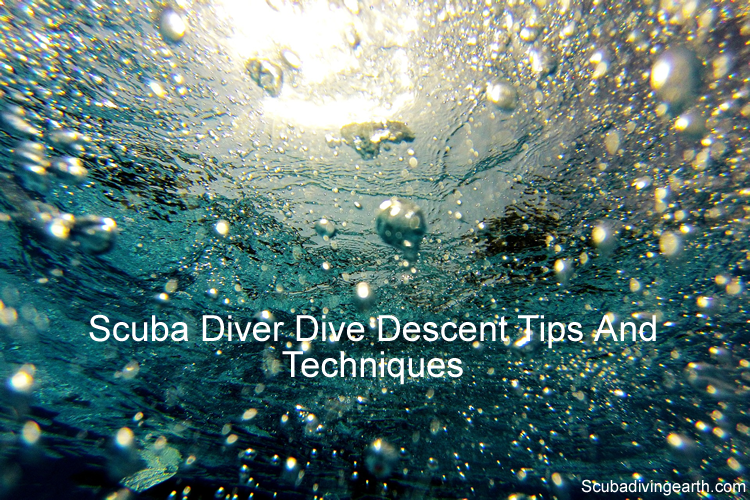
45. Learn to relax when you scuba dive
Learning to relax when you scuba dive provides many benefits. The first of which is making it easier to descend.
If you’re not relaxed, you will be flailing your arms and kicking your feet, which will prevent your from descending. You will also more likely hold more air in your lungs, which will create more buoyancy too. Relax and learn to breath normally to aid your descent.
46. Extend your BCD inflator hose as high as you can
When you are dumping air at the start of your dive, learn to extend your inflator hose as high as possible. Air always rises to the highest point, so you want to make it easy for the air to escape from your BCD.
47. Descending with a drysuit
If you’re diving with a dry suit you should learn to dump as much air from your dry suit when you’re on the boat before you jump in the water.
To do this, break the seal on your neck seal by inserting your fingers between the seal and your neck, whilst at the same time performing a squat. As you squat down, you’re feel and hear the air escaping from your neck.
As you rise up from the squat remove your fingers from your neck seal.
48. Scuba diving in sea water vs fresh water
Remember that sea water is more buoyant than fresh water, which means you’ll need more weight on your weight belt when you dive in the sea.
49. Use a duck dive or surface dive to aid your descent
To help your descent at the start of your dive you can use the duck dive or surface dive technique, as you would when you snorkel. But never dive under-weighted. This will cause problems on your ascent, when your dive tank is lighter and the air has been mostly used up.
More Reading: Do empty scuba tanks float? (This depends on the material they are made from)
50. You’ll need different weight-belt weights with different dive-suit insulation
Each dive suit insulation will require different weight compensation. A thin wetsuit will take less weight on your belt than a thicker wetsuit does. Also, dry-suit diving also requires a different amount of weight too.
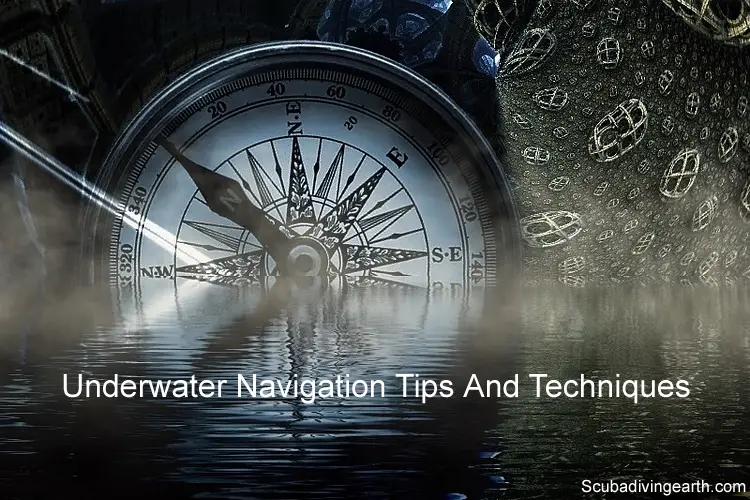
51. Always dive with a compass
Navigation underwater is different to navigating on land. Most find it more difficult to navigate underwater.
The best way you navigate your way when you’re scuba diving is to use a compass.
In addition to a compass, you can use the underwater typography for navigation. To do this pay attention to the underwater features, both natural and artificial. This is especially important and useful on a dive where the intention is to return along the same path as the out-bound dive covered.
G. Scuba diving travel tips for beginner scuba divers
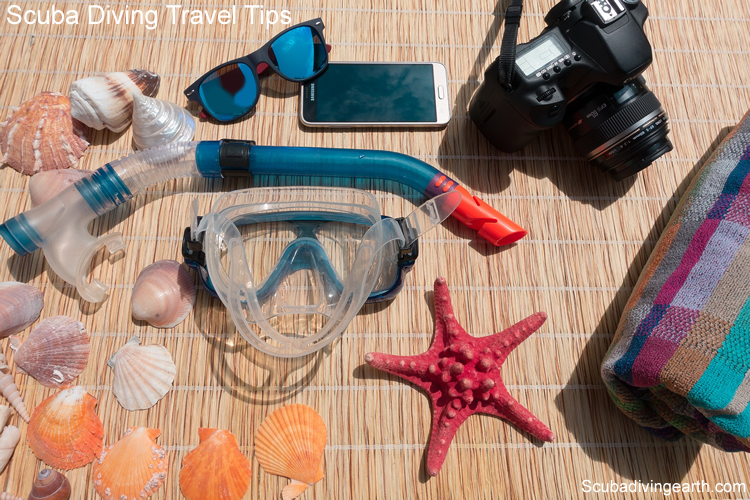
53. Holiday insurance for scuba diving
Make sure your travel insurance covers you for scuba diving, and if it does, check the policy terms to see what type of diving it permits and/or disallows.
54. Traveling with scuba equipment
When you dive overseas on a holiday or vacation, you’ll need to decide whether you travel with your own scuba diving equipment or not. If you decide to hire the equipment on holiday or vacation, I suggest you at least take your own mask, snorkel and fins.
I’d also add your dive computer to this list.
55. Keep your dive computer in your hand luggage
When you fly always put your dive computer in your hand luggage. Dive computers are expensive for one, and this stops it from being stolen. Also, it’s better to keep it within the warm pressurised cabin with you.
56. Handy bags for your kit
Transporting your scuba equipment from your hotel room to the dive boat requires you to use a dive bag. If you carry your dive kit in a specially designed dive bag, this can be used. But if you travel using a regular suitcase, you’ll need a specially designed collapsible dive bag to take your dive gear on the boat.
57. Money and credit card watertight container or bag
Another useful addition to your travel kit is a watertight container or bag. Many times on a dive boat it gets choppy and water comes on board. So put your money, cards and your mobile phone in this watertight container.
58. Buy a travel BCD
If you decide to travel with your own scuba kit, consider investing in a travel BCD. These are lighter and less bulky than regular BCDs.
59. Flying after you scuba dive
Be safe and leave at lest 24 hours between your last dive and when you fly. When you’re on holiday or vacation always take the last day as a dive-free day.
More Reading: How long should you wait to fly after diving? (What’s safe?)
H. Wildlife scuba diving tips for beginner scuba divers
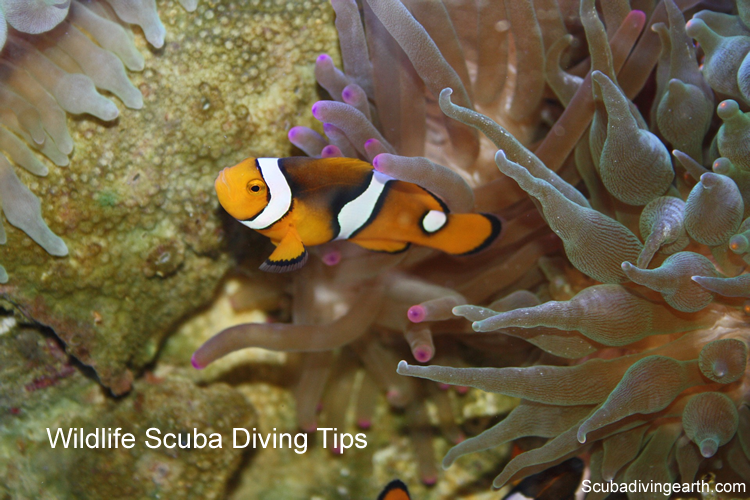
60. Scuba diving with sharks
When you dive with sharks, firstly enjoy the experience and relax, but don’t attempt to touch or harass them.
Also, if you’re keen on scuba diving with sharks when you’re diving from a dive boat, make sure you’re first in the water, as often times any sharks that are around disappear when scuba divers enter the water. If you’re first in, at least you’ll be one of the divers to see them.
61. Always explain to the dive master or skipper your interest in sharks
If you have a particular interest in diving with sharks, it’s always worthwhile mentioning to the skipper of the boat or the dive master, as they are always happy to accommodate divers interests.
Subject to the other scuba divers on the boat, they will many times arrange dives where there’s more chance to see sharks. This also applies to any other interest you have too, not just to diving with sharks.
62. Scuba diving with seals
Seals are naturally timid creatures, as are most wild animals. The best way to encourage seals to approach you on a dive is to float neutrally buoyant on your back. They will often approach you when you’re in this position and play with your fins.
63. If you see dolphins on a dive boat
If you are fortunate enough to see a pod of dolphins when you’re on a dive boat, grab your mask, fins and snorkel and enter the water carefully and slowly. Swim to the pod very slowly and quietly. You may be even more fortunate and see them under the water too.
64. Spotting the small stuff when scuba diving
Sometimes the small stuff is just as exciting to see as the big stuff. To see this you have to swim slowly and get close, but not touch, the coral. Look into and under crevices and peer under overhangs. Watch for the slightest of movement, as sometimes creatures are camouflaged, e.g. octopuses change colour and blend in to the background.
If you need reading glasses, think about getting lenses for your scuba mask so you don’t miss anything close-by.
65. Coral reef etiquette for scuba divers
Always be careful around coral reefs. Corals take years to grow and it takes only a few reckless divers to destroy them. Be aware of your equipment and secure anything that may bash into the reef.
Control your buoyancy and be aware of your fins. Never take anything from a coral reef, which includes what you may think are dead seashells, as these often house tiny creatures, including hermit crabs.
66. Don’t miss the big stuff out in the blue
Don’t only focus on whats in front of you or below you, as often times you’ll miss the bigger underwater creatures that swim past in the blue. They can also be behind you too.
For example, seals have a tendency to follow directly behind you, and can sometimes be found tugging at your fins behind your back. Also, looking out into the blue you get to see some great sights, which may include sharks, rays and turtles, so look in all directions.
As with the need for glasses to see the closeup stuff, if you need glasses for distance don’t let this stop you from seeing things on our dive. Get lenses for your dive mask.
I. Air conserving tips for beginner scuba divers
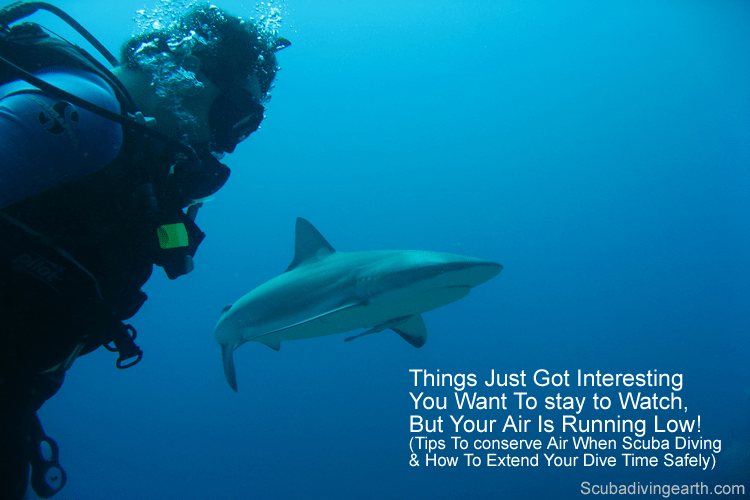
If you learn how to conserve your air when you scuba dive, you’ll extend your dive time and enjoy longer dives. To read more about learning air conserving tips when scuba diving, read this full article which lists 28 tips to conserve air when scuba diving.
67. Always have your snorkel attached to your mask
Having your snorkel attached to your mask when you scuba dive will mean that you can use it to snorkel when you first jump in the water, before you commence your dive. Using your snorkel at the start of your dive instead of your regulator, means you’ll conserve the air in your dive tank. Which means more air for your dive.
68. Fill your BCD by using your mouth at the surface
To conserve the air in your dive tank, fill you BCD with your own breath to provide your initial buoyancy at the surface.
69. Relax when you’re scuba diving
Relaxing when you’re scuba diving will also benefit your air consumption. If you’re over exerting yourself because you’re not relaxed, you’ll consume more air on your dive. Relax and use less air and extend your dive time.
70. Scuba dive with the correct weight on your weight-belt
Diving with too much weight on your weight belt will result in using more air than you need to for buoyancy control. Whilst beginner scuba divers are usually ‘over-weighted’ for safety purposes when they first learn, aim to perfect your weight as soon as you can.
71. Take your scuba diving slowly
Water is around 800 times more dense than air. This means that it’s harder to perform any action underwater as a result. The resistance on your body in huge, so take things slowly and conserve your energy, which in turn will help reduce your air consumption too.
J. Dive time extension tips for beginner scuba divers

72. Check your contents gauge at the surface
If your dive tank is not full at the start of your scuba dive, change it for one that is. Otherwise you’re automatically shortening your dive time.
73. Use a larger 15 litre (100 Cubic Foot) dive tank
Increasing the size of your dive tank will extend your dive time. Opt for a 15 litre (100 Cubic Foot) diving cylinder if one’s available, as this gives you around 27% more air than the more common 12 litre (80 Cubic Foot) air tank.
74. Use a set of twin dive tanks
By twinning your 12 litre (80 Cu Ft) dive tanks and opting for a twin-set, you’re doubling your air.
75. Consider a rebreather
Rebreathers offer scuba divers a much longer bottom time. So if you want to extend your dive time, consider investing in one.
K. Scuba diving safety tips for beginner scuba divers
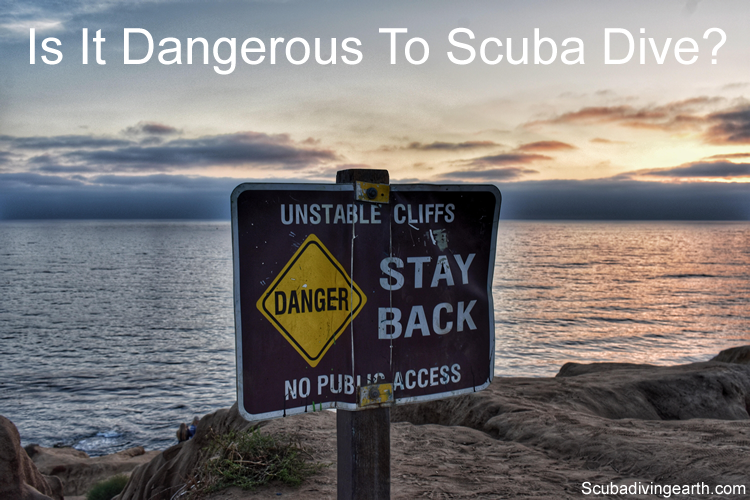
I consider safety a top priority for scuba diving, that’s why I wrote a compete article which includes 26 rules for safe scuba diving. If you want to learn more about scuba safety, please feel free to also read that article too.
76. Aim to make scuba diving a safe sport
Doing something with intention makes a huge difference to the outcome. So learn to dive with safety in mind. Scuba diving is classified as a dangerous sport as there are fatalities, but if you follow safe diving practices and always dive with a buddy, you’ll reduce this risk to almost nil.
77. Never be afraid to abort a dive
There may be times in your scuba diving experience that you don’t feel like scuba diving for whatever reason. It doesn’t matter what the reason is, but if you feel strong enough about the feeling, never be afraid to abort the dive. This applies either before the dive commences or during the dive itself.
78. Always carry an alternative air source
All diver training centres teach the importance of carrying an alternative air source. Never dive without one and never dive with a buddy that doesn’t have one either.
Occasional scuba diving equipment fails, when this failure is the regulator or a hose that connects to the regulator, it’s vital to have backup for this eventuality.
An alternative air source could save yours or yours buddy’s life.
79. Always use bold hand signals
Underwater our only form of communication is by using hand signals or using a writing pad, unless you invest in expensive underwater communication equipment. Any communication should be done using bold hand signals, which especially applies to diver safety signals.
80. Plan your dive and dive your plan
Safe diving involves planning your dives before you dive, but then sticking to that dive plan. Planning your dive includes for example, the depth of the dive, the length of time for the dive, whether the dive will involve decompression stops, who will lead the dive, etc.
81. Check your air on a regular basis
All scuba divers should check their air on a regular basis. This is especially highlighted in the DAN report which shows that 41% of scuba diver deaths were triggered by insufficient gas (air). With 27% of cases where insufficient air was the disabling agent.
82. Always return to the surface with 50 BAR or 500 PSI of air left in your dive tank
You should always return to the surface after a dive with at least 50 BAR or 500 PSI in your dive tank at the end of a dive. This means that when you leave the bottom, you should take account of your air consumption during your ascent.
Make sure when you do your calculation that you take account of any decompression and safety stops on the way up.
83. Know your limitations
As scuba diving is a dangerous sport, it’s important that you only ever dive within your own limitations and experience. This applies to the depth you dive and to the conditions of the water you’re diving in. This applies to the water temperature, water visibility and whether there are any currents and tides in the water you’re intending to scuba dive.
84. Never hold your breath
Underwater there are large pressure changes at different depths. These pressure changes have a significant affect on the air in your lungs, which is especially important to understand on your ascent. Air expands as you ascend and expands the most in the last few metres or feet of a dive. For example in the last 10 metres (33 feet), the pressure halves, which means the air volume in your lungs would double.
This is why it’s crucial for your safety to never hold your breath. Doing so could cause you harm and in the worst case scenario lead to death.
85. Wreck diving tips
Never penetrate a wreck on a scuba dive, unless it has first been planned. The plan for wreck penetration should include the entry and exit routes, which should be clearly identified. You should also consider all the risks associated when entering the wreck.
86. Don’t consume excessive amounts of alcohol before scuba diving
Common sense tells us that drinking excessive amounts of alcohol before scuba diving would not be good for us. Drinking alcohol and the after effects of alcohol poisoning can affect the body in a number of ways. These can be anything from dehydration through to impaired thoughts and motor skills.
87. Perform a safety stop at 5-6 metres (16-20 feet) for 3-5 minutes on all dives
If you view every dive as a decompression dive, because it is (see this article on decompression stops vs safety stops), then you’ll have a slightly different view on ascending from every dive. Safe diving practice advises to stop at 5-6 metres (16-20 feet) for between 3-5 minutes.
Every scuba diver is different. Different weights, different levels of hydration and all divers are physiologically different in many other aspects. Which means that they all decompress at different rates during their ascent. So why not be extra safe and spend 3-5 minutes of extra decompression time before your final ascent.
88. Do extra planning for deeper dives
The deeper you dive, the greater the risks. If you are diving to deeper depths, you must do extra safety planning for your scuba dives. These additional plans should include whether you intend to plan in any decompression stops for the depth and time of the dive concerned. Carefully plan your air requirements for a deeper dive, as the deeper you go, the more air you consume.
Never dive deeper than your scuba diving qualification limits you to.
L. Scuba buddy diving tips for beginner scuba divers
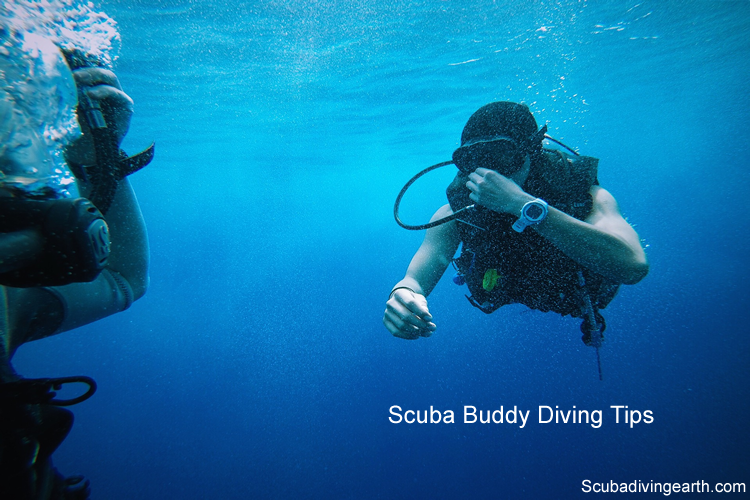
89. Always perform buddy checks before each dive
The purpose of buddy checks is to first check that both your equipment and that of your buddy works as it should. A buddy check is also to familiarise each of you with the other’s equipment.
This second reason is key for if anything goes wrong on the dive. Whereas the first reason for the check is to avoid problems in the first place.
90. Use the ABC for a buddy check
Make the buddy check easy by using an easy way to remember all the checks.
Do a buddy check using the ABC method, where:
- ‘A’ is for air checks and should be applied to your main regulator and your alternative air source;
- ‘B’ is for buoyancy controls, where the checks should include inflation and deflation of your BCD and/or your dry suit;
- ‘C’ is for clips and releases, which should include your BCD and your weight belt clips and releases.
91. Agree in your buddy check to not wait to use your buddy’s alternative air source
If you have an air source problem underwater, speed is of the essence. It’s better to agree during your buddy check with your buddy that it’s okay to take the alternative air source without having to ask for it.
The buddy check confirms its location and how to access it should it be necessary to use.
92. Never take your buddy’s regulator out of their mouth
Whilst it’s okay to take your buddy’s alternative air source in an emergency. It’s not okay to grab their main air source or regulator that’s in their mouth from them. This would put your buddy in danger, but would also lessen your chances of surviving the situation too.
93. Always ascend with your dive buddy
You should always ascend together with your dive buddy from your dive. Face each other on the ascent and always carry out the same slow ascent and both do the same decompression stops, including the extra safety stop at 5-6 metres (16-20 feet).
94. What to do if you lose your buddy
If you lose your dive buddy when you’re scuba diving, after a quick check on the bottom, you must surface. This should be part of your diver briefing and dive plan before you enter the water.
95. Give fellow divers space
Whilst on the one hand you want to always be within a few fin strokes of your dive buddy and at least within eyesight of them, also be aware of giving your dive buddy space on a dive. You don’t want to be constantly knocking into your dive buddy.
96. Never stray too far from your buddy
Your dive buddy should always be within eyesight and within a few fin strokes. If you have an air-source problem, you be able to see where they are and to reach them quickly.
97. Know where your buddy is at all times
Knowing where your buddy is at all times is diving within safe diving practices. Should a problem arise for you or for them, you’ll know where they are immediately.
98. Low visibility diving safety
On low visibility dives it’s much more difficult to keep in eyesight of your buddy. You therefore need to be extra vigilant when diving in lower visibility.
99. Look for signs in your buddy
Scuba diving is about enjoyment, but it’s also about being aware too. You are taught to dive in buddy pairs for a reason. One of those reasons is for you to look after each other. Be alert and look for signs that may indicate that your buddy (or any other divers in your group) are not okay.
If you spot anything unusual, act accordingly. One example of where this applies is nitrogen narcosis. Understand the symptoms and know how to spot them.
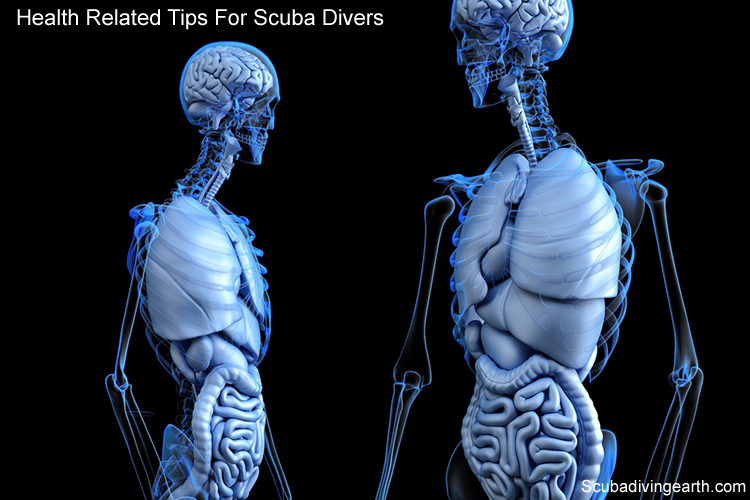
100. Stay hydrated and drink plenty of water before you dive
Staying hydrated is the top of the tips for beginner scuba divers in the health category.
As with doing any sport, it’s also important to be well hydrated for scuba diving too. A dehydrated scuba diver may be more likely to suffer from cramp, have reduced awareness and it could lead to poorer air consumption. There’s also the possibility of an increased risk of decompression sickness on ascent from the dive.
So always drink plenty water before and after scuba diving.
101. Make sure you’re fit to dive
Diving is a physical sport, so it’s important to be physically fit before you dive. Also be aware of the impact the pressures of the water has on your body too. In the DAN survey 26% of scuba diving fatalities are associated with cardiac events, mostly in older divers.
102. Keep up your energy when scuba diving
As scuba diving involves physical activity, eating food beforehand is always advisable. Also, it’s a good idea to take food to eat between dives to keep up your energy levels. Bananas are always a good source of energy for scuba divers.
103. Sea sickness tablets for diving on a boat
If you’re unfortunate enough to suffer from sea sickness, the best option is to take sea sickness tablets. Always follow the guidance for taking the pills. Most require you to take these tablets quite some time before you get on the dive boat, so that the sea sickness tablets have time to work. Be warned that some sea sickness tablets can make you drowsy.
104. Take yoga classes to improve your fitness and breathing technique
Another reason for staying fit and for improving your breathing technique is for conserving air as a scuba diver. Yoga is a great way to improve you physically too.
105. Scuba diving with a hole in the heart
You need to be more cautious when scuba diving with a hole your heart. Scuba divers with a hole in the heart are more prone or susceptible to decompression sickness.
This is possibly caused by their heart being less efficient than a heart without a hole. If you are aware you have a hole in the heart, it may be worth speaking to your doctor and taking advice.
But in any event, if you continue to dive with a hole in the heart, be extra cautious with your decompression on the ascent from any depth dive, take extra safety stops too.
106. Scuba diving with Asthma
The debate over whether or not you should dive with asthma is still raging. If you do have asthma, you should seek medical advice as to whether your asthma is severe enough to prevent you from scuba diving.
107. Scuba diving with a disability
Depending on the disability and how this affects you physically, then it’s still possible to dive. When weighing up whether or not the disability affects you when diving, you need to consider your own personal safety and of those around you.
In a dive-buddy setup for example, dive buddy’s are there to help each other. With your disability, would you be able to help your buddy, should they get into difficulty. There are ways to overcome this, which may involve diving in at least three or more divers to reduce the risk.
The other aspect to consider if you have a disability is to consider how deep you dive, as the deeper you go you add more risk.
I hope you enjoyed this article about tips for beginner scuba divers
I’d love to hear from you. Tell us about your adventures of diving and snorkeling, in the comments below. Please also share your photos. Either from your underwater cameras or videos from your waterproof Gopro’s!
If this article hasn’t answered all of your questions. If you have more questions either about snorkeling or scuba diving (or specifically about tips for beginner scuba divers), please comment below with your questions.
There will also be many more articles about scuba diving (and snorkeling) for you to read and learn about these fabulous sports.
Have fun and be safe!

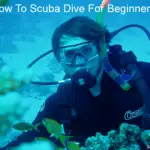
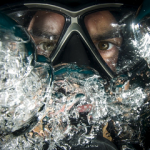
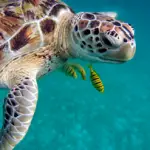
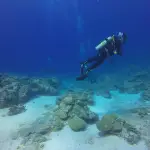

I appreciate it when you suggested returning to the surface after the person had dived in order to let everyone know that they are alright. I might forget that, so I will ask my diving buddy to remind of this later. There are times when I become too excited that I I forget the things that I need to pay attention to. Thank you.
I’m not sure what you mean by returning to the surface to let everyone know that they are alright. I think you’ve misunderstood my comment. But what I did say was this “You should always return to the surface after a dive with at least 50 BAR or 500 PSI in your dive tank at the end of a dive.”